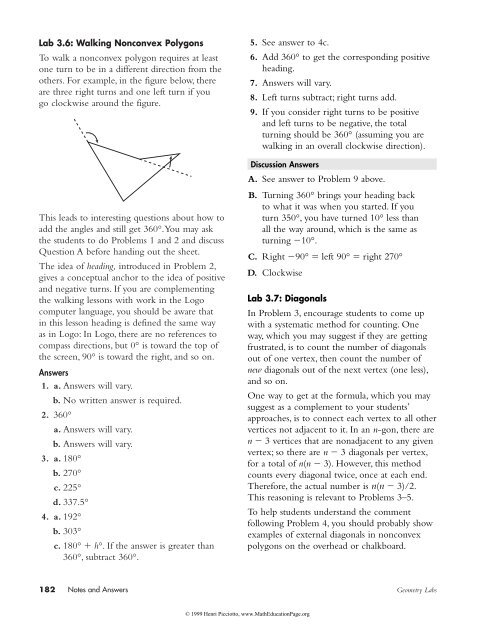Create successful ePaper yourself
Turn your PDF publications into a flip-book with our unique Google optimized e-Paper software.
Lab 3.6: Walking Nonconvex Polygons<br />
To walk a nonconvex polygon requires at least<br />
one turn to be in a different direction from the<br />
others. For example, in the figure below, there<br />
are three right turns and one left turn if you<br />
go clockwise around the figure.<br />
This leads to interesting questions about how to<br />
add the angles and still get 360°.You may ask<br />
the students to do Problems 1 and 2 and discuss<br />
Question A before handing out the sheet.<br />
The idea of heading, introduced in Problem 2,<br />
gives a conceptual anchor to the idea of positive<br />
and negative turns. If you are complementing<br />
the walking lessons with work in the Logo<br />
computer language, you should be aware that<br />
in this lesson heading is defined the same way<br />
as in Logo: In Logo, there are no references to<br />
compass directions, but 0° is toward the top of<br />
the screen, 90° is toward the right, and so on.<br />
Answers<br />
1. a. Answers will vary.<br />
b. No written answer is required.<br />
2. 360°<br />
a. Answers will vary.<br />
b. Answers will vary.<br />
3. a. 180°<br />
b. 270°<br />
c. 225°<br />
d. 337.5°<br />
4. a. 192°<br />
b. 303°<br />
c. 180° h°. If the answer is greater than<br />
360°, subtract 360°.<br />
5. See answer to 4c.<br />
6. Add 360° to get the corresponding positive<br />
heading.<br />
7. Answers will vary.<br />
8. Left turns subtract; right turns add.<br />
9. If you consider right turns to be positive<br />
and left turns to be negative, the total<br />
turning should be 360° (assuming you are<br />
walking in an overall clockwise direction).<br />
Discussion Answers<br />
A. See answer to Problem 9 above.<br />
B. Turning 360° brings your heading back<br />
to what it was when you started. If you<br />
turn 350°, you have turned 10° less than<br />
all the way around, which is the same as<br />
turning 10°.<br />
C. Right 90° left 90° right 270°<br />
D. Clockwise<br />
Lab 3.7: Diagonals<br />
In Problem 3, encourage students to come up<br />
with a systematic method for counting. One<br />
way, which you may suggest if they are getting<br />
frustrated, is to count the number of diagonals<br />
out of one vertex, then count the number of<br />
new diagonals out of the next vertex (one less),<br />
and so on.<br />
One way to get at the formula, which you may<br />
suggest as a complement to your students’<br />
approaches, is to connect each vertex to all other<br />
vertices not adjacent to it. In an n-gon, there are<br />
n 3 vertices that are nonadjacent to any given<br />
vertex; so there are n 3 diagonals per vertex,<br />
for a total of n(n 3). However, this method<br />
counts every diagonal twice, once at each end.<br />
Therefore, the actual number is n(n 3)/2.<br />
This reasoning is relevant to Problems 3–5.<br />
To help students understand the comment<br />
following Problem 4, you should probably show<br />
examples of external diagonals in nonconvex<br />
polygons on the overhead or chalkboard.<br />
182 Notes and Answers Geometry Labs<br />
© 1999 Henri Picciotto, www.MathEducationPage.org






